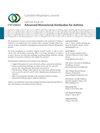慢性阻塞性肺病肺炎和非肺炎加重患者CRP、降钙素原、中性粒细胞计数、嗜酸性粒细胞计数、sTREM-1和OPN的比较
IF 2.1
4区 医学
Q3 RESPIRATORY SYSTEM
引用次数: 3
摘要
社区获得性肺炎(CAP)合并慢性阻塞性肺疾病急性加重期(AECOPD)患者发生急性、重度呼吸系统疾病的风险高于未合并CAP的患者。因此,早期识别AECOPD的肺炎是非常重要的。方法:本前瞻性观察研究纳入来自两个临床中心的52例AECOPD + CAP患者和93例AECOPD患者。比较AECOPD和AECOPD + CAP患者入院第一天血中骨桥蛋白(OPN)、髓样细胞可溶性触发受体-1 (sTREM-1)、c反应蛋白(CRP)、降钙素原(PCT)、嗜酸性粒细胞(EOS)计数、中性粒细胞(Neu)计数及临床症状。此外,根据目前吸入糖皮质激素(ICS)或全身皮质激素(SCS)的使用情况,进行生物标志物差异的亚组分析。结果与AECOPD患者相比,AECOPD + CAP患者痰量增加、痰脓增多、糖尿病发生率增高、住院时间延长(p < 0.05)。临床logistic回归模型显示,在常见临床症状中,化脓痰可以独立预测AECOPD患者在调整糖尿病病史后的肺炎。在第1天,AECOPD + CAP患者的Neu、CRP、PCT和OPN值较高,而两组的血清sTREM-1水平和EOS计数相似。CRP与CAP预测AECOPD效果最好(p < 0.05,差异检验),而OPN与Neu、PCT和脓性痰具有相似的准确性(p < 0.05,差异检验)。包括临床症状和生物标志物在内的多变量分析表明,第1天CRP≥15.8 mg/dL是AECOPD中肺炎的唯一有希望的预测因子。ICS和SCS对CRP和OPN均无影响。结论CRP≥15.8 mg/dL是AECOPD患者肺炎的理想预测指标,其血浆水平不受ICS或SCS的影响。当与临床症状或其他标志物(OPN、PCT、Neu)联合使用时,CRP的诊断性能没有明显提高。本文章由计算机程序翻译,如有差异,请以英文原文为准。
Comparison of CRP, Procalcitonin, Neutrophil Counts, Eosinophil Counts, sTREM-1, and OPN between Pneumonic and Nonpneumonic Exacerbations in COPD Patients
Introduction The patients with community-acquired pneumonia (CAP) and acute exacerbations of COPD (AECOPD) could have a higher risk of acute and severe respiratory illness than those without CAP in AECOPD. Consequently, early identification of pneumonia in AECOPD is quite important. Methods. 52 subjects with AECOPD + CAP and 93 subjects with AECOPD from two clinical centers were enrolled in this prospective observational study. The values of osteopontin (OPN), soluble triggering receptor expressed on myeloid cells-1 (sTREM-1), C-reactive protein (CRP), procalcitonin (PCT), eosinophil (EOS) counts, and neutrophil (Neu) counts in blood on the first day of admission and clinical symptoms were compared in AECOPD and AECOPD + CAP. In addition, subgroup analyses of biomarker difference were conducted based on the current use of inhaled glucocorticoids (ICS) or systemic corticosteroids (SCS). Results Patients with AECOPD + CAP had increased sputum volume, sputum purulence, diabetes mellitus, and longer hospital stays than AECOPD patients (p < 0.05). A clinical logistic regression model showed among the common clinical symptoms, purulent sputum can independently predict pneumonia in AECOPD patients after adjusting for a history of diabetes. At day 1, AECOPD + CAP patients had higher values of Neu, CRP, PCT, and OPN, while serum sTREM-1 levels and EOS counts were similar in the two groups. CRP fared best at predicting AECOPD with CAP (p < 0.05 for the test of difference), while OPN had similar accuracy with Neu, PCT, and purulent sputum (p > 0.05 for the test of difference). Multivariate analysis, including clinical symptoms and biomarkers, suggested that CRP ≥15.8 mg/dL at day 1 was a only promising predictor of pneumonia in AECOPD. CRP and OPN were not affected by ICS or SCS. Conclusions CRP ≥15.8 mg/dL is an ideal promising predictor of pneumonia in AECOPD, and its plasma level is not affected by ICS or SCS. The diagnostic performance of CRP is not significantly improved when combined with clinical symptoms or other markers (OPN, PCT, and Neu).
求助全文
通过发布文献求助,成功后即可免费获取论文全文。
去求助
来源期刊

Canadian respiratory journal
医学-呼吸系统
CiteScore
4.20
自引率
0.00%
发文量
61
审稿时长
6-12 weeks
期刊介绍:
Canadian Respiratory Journal is a peer-reviewed, Open Access journal that aims to provide a multidisciplinary forum for research in all areas of respiratory medicine. The journal publishes original research articles, review articles, and clinical studies related to asthma, allergy, COPD, non-invasive ventilation, therapeutic intervention, lung cancer, airway and lung infections, as well as any other respiratory diseases.
 求助内容:
求助内容: 应助结果提醒方式:
应助结果提醒方式:


